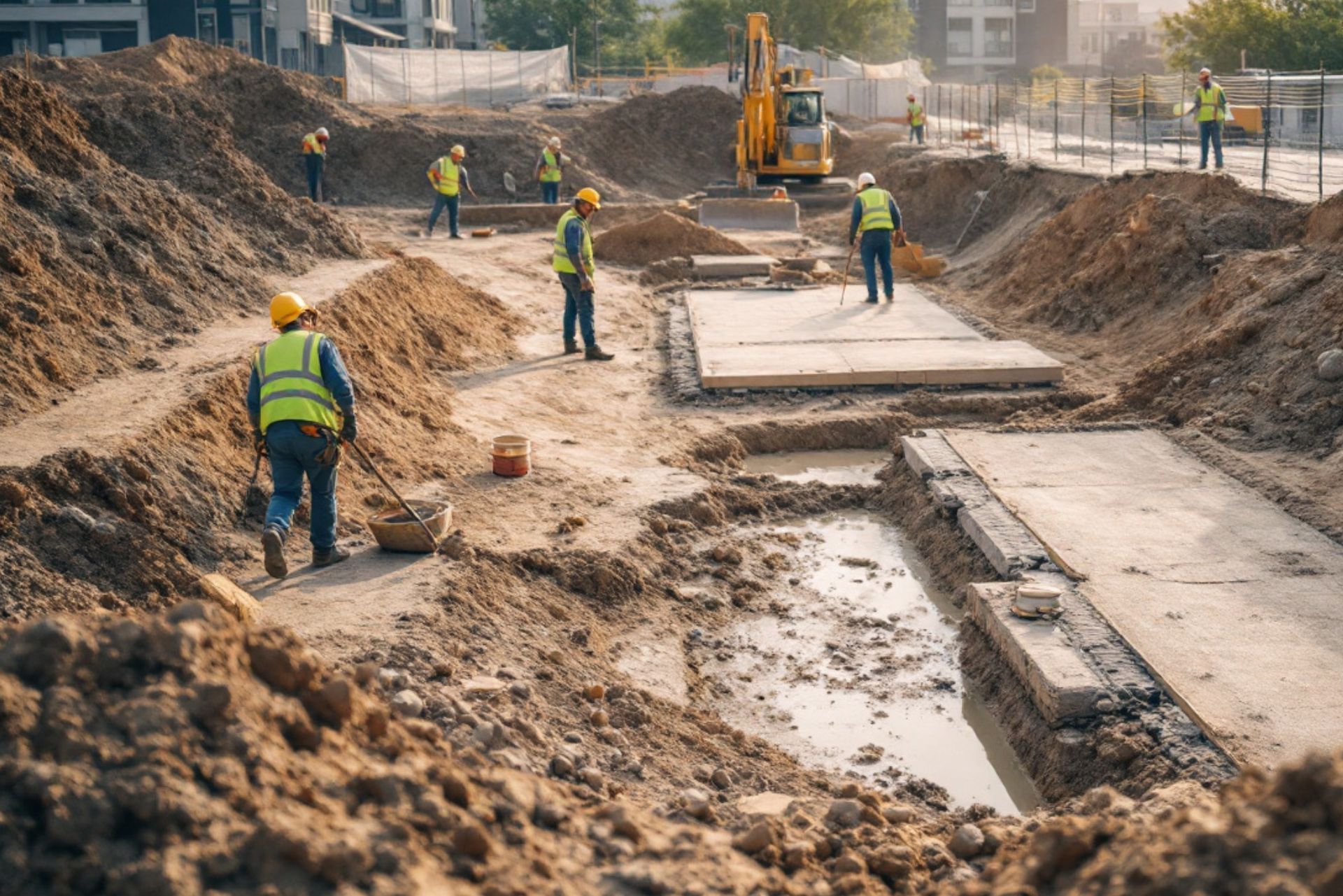Pollution Liability Insurance For Contractors

See How We're Different:
or call us: 619-719-5818
Top 3 Recommended Policies
Index
Understanding Pollution Liability Insurance
Who Needs Pollution Liability Insurance?
Coverage Details of Pollution Liability Insurance
The Cost of Pollution Liability Insurance
How to Choose the Right Pollution Liability Insurance Provider
Claims Process and Legal Aspects
Conclusion: Protecting Your Business with Pollution Liability Insurance
Contact Us
Phone
Location
As environmental concerns grow and regulations become more stringent, pollution liability insurance has emerged as an essential safeguard for contractors and construction professionals. This comprehensive guide explores the ins and outs of pollution liability insurance, its significance, who should consider it, coverage details, cost implications, and important factors to consider when choosing a provider. Through a thorough understanding of these topics, contractors can protect their businesses against unforeseen pollution-related liabilities.
Understanding Pollution Liability Insurance
Pollution liability insurance is a specialized type of insurance designed to cover claims arising from environmental damage or pollution incidents. It serves as a critical tool for contractors who may inadvertently cause pollution during the course of their work.
Definition and Importance of Pollution Liability Insurance
Pollution liability insurance protects contractors from financial losses resulting from pollution-related incidents, which could include cleanup costs, legal fees, and compensation for damages. This coverage is vital because traditional general liability insurance often excludes environmental damages, leaving contractors vulnerable to potentially devastating financial repercussions.
The importance of this insurance cannot be overstated; in today's regulatory landscape, environmental incidents can lead to significant legal liabilities and loss of reputation. Contractors engaging in industries such as construction, demolition, waste management, and environmental services should seek this additional layer of protection. Moreover, with increasing public awareness and concern over environmental issues, having pollution liability insurance can enhance a contractor's credibility and demonstrate their commitment to responsible practices, which can be a significant competitive advantage in the marketplace.
Key Features of Pollution Liability Insurance
Pollution liability insurance typically includes several key features: coverage for third-party bodily injury and property damage, clean-up costs, and even expenses related to regulatory defense. These features ensure that contractors have comprehensive protection in the event of a pollution incident.
Furthermore, many policies are customizable, allowing contractors to tailor their coverage to fit their specific needs and risks associated with their trade. This flexibility makes it an invaluable component of risk management for contractors across various sectors. Additionally, some policies may offer coverage for gradual pollution incidents, which can be particularly relevant for contractors involved in projects where environmental impacts may not be immediately apparent. This aspect of coverage is crucial, as it acknowledges the long-term effects of pollution and provides a safety net for contractors who may face claims years after a project has been completed.
Another noteworthy feature is the inclusion of coverage for transportation-related pollution incidents, which is essential for contractors who handle hazardous materials or waste. This can encompass incidents that occur during the transport of materials to and from job sites, further broadening the scope of protection. By understanding these key features, contractors can make informed decisions about their insurance needs and ensure they are adequately protected against the myriad of risks associated with pollution liability.
Who Needs Pollution Liability Insurance?
Not all contractors are at equal risk when it comes to pollution. Understanding who needs pollution liability insurance is key to effective risk management and financial planning.
Identifying High-Risk Contractor Professions
Certain contractor professions are inherently riskier in terms of pollution exposure. These include:
- General Contractors
- Demolition Contractors
- Excavation Contractors
- Environmental Remediation Contractors
- Waste Management Contractors
- Industrial Cleaning Contractors
Professionals in these fields often handle hazardous materials, operate heavy machinery, and are involved in projects that have a higher likelihood of causing environmental harm. Therefore, having pollution liability insurance is crucial for them. For instance, demolition contractors may encounter asbestos or lead paint, while excavation contractors might disturb contaminated soil, increasing their exposure to liability claims. In addition, the nature of their work often means they are operating in areas where environmental regulations are stringent, making compliance essential to avoid hefty fines and legal repercussions.
Assessing Your Business's Pollution Risk
Each contractor should conduct a thorough risk assessment to determine their exposure to pollution-related liabilities. This assessment should cover the following areas:
- The type of projects undertaken
- The materials used during construction or renovation
- Past incidents or claims related to pollution
- Local regulations and environmental laws
By actively evaluating these factors, contractors can gain insight into their specific pollution risks and make informed decisions about the insurance coverage they require. Moreover, it is beneficial to engage with environmental consultants who can provide expert analysis and help identify potential hazards that may not be immediately apparent. Regular training for staff on handling hazardous materials and understanding environmental compliance can also mitigate risks, ensuring that everyone involved is aware of the protocols and best practices to follow. This proactive approach not only safeguards the environment but also protects the contractor's reputation and financial stability.

Coverage Details of Pollution Liability Insurance
A clear understanding of what pollution liability insurance covers is essential for contractors to ensure they have adequate protection.
What Does Pollution Liability Insurance Cover?
This insurance generally covers:
- Third-party bodily injury claims related to pollution
- Third-party property damage arising from pollution incidents
- Costs associated with the cleanup of contaminated sites
- Legal fees for defense against pollution claims
- Regulatory fines and penalties in some instances
By encompassing these key areas, pollution liability insurance provides a safety net that allows contractors to operate with peace of mind, knowing they are financially protected if an incident occurs. Additionally, many policies may also cover the costs of public relations efforts to mitigate reputational damage following a pollution incident. This aspect is particularly crucial in today’s digital age, where news can spread rapidly, and a company’s reputation can be severely impacted by environmental mishaps. Furthermore, some insurers offer risk management services as part of their coverage, helping contractors implement best practices to minimize the likelihood of pollution events.
Exclusions and Limitations of Pollution Liability Insurance
However, it is equally important to be aware of the exclusions within pollution liability insurance policies. Common exclusions may include:
- Gradual pollution or long-term exposure
- Pollution incidents occurring outside of the covered policy period
- Intentional acts or criminal activities
- Damage caused by specific pollutants such as asbestos or lead unless explicitly included
Being informed about these limitations allows contractors to identify potential gaps in their coverage and seek additional insurance solutions if necessary. It’s also worth noting that some policies may have specific conditions regarding how claims are reported and managed, which can affect the overall coverage experience. For instance, failing to report a pollution incident within a stipulated timeframe could lead to denial of a claim. Understanding these nuances is critical for contractors to navigate their insurance landscape effectively and ensure they are fully equipped to handle any potential environmental liabilities that may arise during their operations.
The Cost of Pollution Liability Insurance
Understanding the financial aspect of pollution liability insurance is critical for contractors aiming to manage their budget effectively while securing essential coverage. This type of insurance is designed to protect businesses from the financial repercussions of environmental damage caused by their operations, which can include cleanup costs, legal fees, and damages to third parties. As environmental regulations become increasingly stringent, the importance of this coverage cannot be overstated.
Factors Influencing Insurance Premiums
Several factors influence the cost of pollution liability insurance premiums, including:
- The contractor's industry and specific risks involved
- The contractor's claims history
- The size and scope of projects undertaken
- The geographical location of the contractor’s operations
- The coverage limits chosen
Contractors should assess these elements when seeking quotes and compare their options to ensure they achieve the best possible rates while maintaining adequate coverage. It's also essential to consider the potential impact of emerging environmental regulations that could affect the risk landscape. For instance, contractors in industries like construction or waste management may face higher premiums due to the inherent risks associated with their work, particularly in areas prone to environmental scrutiny.
Tips to Reduce Your Insurance Costs
There are several strategies contractors can employ to lower their insurance costs:
- Implementing strict safety and environmental protocols to reduce claims
- Consolidating insurance needs with fewer providers for discounts
- Regularly reviewing and updating risk assessments
- Participating in risk management training or workshops
By taking proactive measures, contractors can not only improve their risk profile but also negotiate more favorable policy terms. Additionally, fostering a culture of environmental responsibility within the organization can lead to long-term savings. For example, investing in sustainable practices not only mitigates risks but can also enhance a contractor's reputation, potentially attracting clients who prioritize environmental stewardship. Furthermore, maintaining open communication with insurance providers can lead to tailored solutions that address specific needs, ensuring that contractors are not overpaying for unnecessary coverage while still being adequately protected.

How to Choose the Right Pollution Liability Insurance Provider
Finding the right insurance provider is crucial for ensuring you receive tailored coverage that meets your business needs. Pollution liability insurance is not just a safety net; it is a vital component for businesses that interact with hazardous materials or operate in environmentally sensitive areas. The right provider will not only protect your assets but also contribute to your company's reputation as a responsible entity committed to environmental stewardship.
Evaluating Insurance Providers
When searching for a pollution liability insurance provider, it's important to evaluate potential candidates based on:
- The insurer's reputation and experience in the environmental insurance market
- The range of coverage options available
- Customer service quality and responsiveness
- Financial stability and claims handling record
These factors can serve as a helpful guide to streamline your selection process and find a reliable provider. Additionally, consider looking into the insurer's track record with similar businesses in your industry. Engaging with industry peers or consulting with a broker who specializes in environmental insurance can provide valuable insights into which providers are most respected and effective in handling claims. It’s also wise to review any available case studies or testimonials that highlight the insurer's ability to respond to pollution incidents effectively.
Questions to Ask Your Potential Insurance Provider
To gain a deeper insight into the coverage offered, contractors should ask their potential insurance providers the following questions:
- What specific pollutants are covered under this policy?
- Are historical pollution incidents covered?
- What is the claims process like?
- Are there deductibles or self-insured retentions?
- Can the policy be tailored to my needs?
Asking these questions will provide clarity regarding the scope of coverage and help to establish a solid professional relationship with the insurer. Moreover, you should inquire about any additional services that the provider may offer, such as risk management advice or environmental compliance assistance. Understanding the full suite of services can enhance your overall risk mitigation strategy and ensure that you are not only covered in the event of an incident but also proactively managing potential exposures. Furthermore, discussing the insurer's approach to ongoing support and communication can help set expectations for how they will assist you in navigating the complexities of environmental regulations and claims management.
Claims Process and Legal Aspects
Understanding the claims process is vital for contractors to ensure they can properly navigate the complexities of pollution liability insurance when a loss occurs. This knowledge not only helps in expediting claims but also protects contractors from potential legal pitfalls that may arise during the process.
Filing a Claim: The Process
The claims process generally involves several steps:
- Notify the insurance provider as soon as a pollution incident occurs.
- Provide documentation, including incident reports and other relevant information.
- Cooperate with the insurance company's investigation process.
- Keep thorough records of all communications throughout the process.
By following these steps and being proactive in communication, contractors can facilitate a smoother claims experience. It is also advisable to establish a clear internal protocol for incident reporting and claims management, which can streamline the process and ensure that no critical steps are overlooked. Training staff on these protocols can further enhance preparedness and reduce the risk of delays when a claim needs to be filed.
Legal Considerations and Compliance
Legal aspects must also be considered when dealing with pollution liability claims. Contractors should familiarize themselves with relevant environmental regulations and ensure compliance to avoid additional complications during claims processing. Consulting with legal experts who specialize in environmental law can offer additional support and guidance. Furthermore, understanding the nuances of state and federal regulations can help contractors anticipate potential legal challenges that may arise from pollution incidents.
In addition to compliance, contractors should also be aware of the potential for third-party claims resulting from pollution incidents. These claims can significantly complicate the claims process and may require additional legal resources to navigate. It is essential for contractors to maintain comprehensive liability coverage and to engage with legal professionals who can assist in mitigating risks associated with environmental liabilities. Regular audits of compliance practices and insurance coverage can also help ensure that contractors are adequately protected against unforeseen events.
Conclusion: Protecting Your Business with Pollution Liability Insurance
In conclusion, pollution liability insurance is a critical investment for contractors operating in high-risk environments. By understanding its importance, coverage details, cost implications, and how to effectively select a provider, contractors can significantly mitigate their exposure to environmental risks.
Recap of Pollution Liability Insurance
To recap, pollution liability insurance is designed to protect contractors from the financial burdens that arise from pollution-related incidents. It covers a range of liabilities—including bodily injury, property damage, and remediation costs. Contractors engaged in high-risk activities should prioritize securing this vital insurance to safeguard their businesses.
Final Thoughts on the Importance of Insurance for Contractors
Ultimately, pollution liability insurance not only provides financial security but also enhances a contractor’s credibility in the marketplace. It demonstrates a commitment to responsible business practices and environmental stewardship. In a landscape where environmental awareness is becoming increasingly important, securing appropriate insurance coverage is not just wise; it's essential for long-term success. Protect your business, your reputation, and the environment by investing in pollution liability insurance tailored to your needs.
